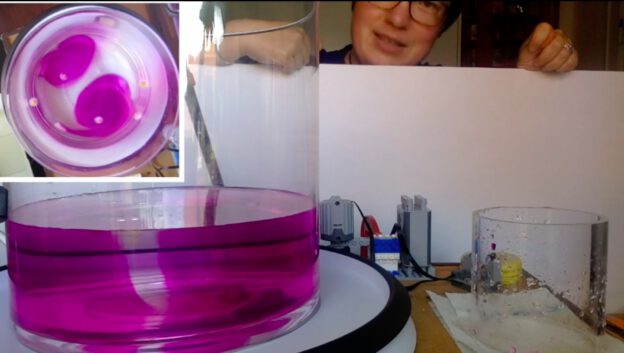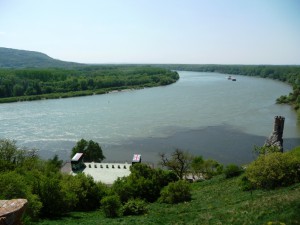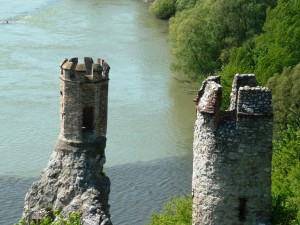Torge and I are planning to run the “tilting of a frontal surface under rotation / cylinder collapse” experiment as “remote kitchen oceanography” in his class on Thursday, so I’ve been practicing it today. It didn’t work out quite as well as it did when Pierre and I were running it in Bergen years ago, so if you are looking for my best movie of that experiment, you should go read the old blog post.
The idea is that a density front is set up by spinning up a tank in which a bottom-less cylinder contains a denser fluid, set up into a less dense fluid. Once the tank is spun up, the cylinder is removed, releasing the denser fluid into the less dense one. In contrast to the non-rotating case, where the dense water would sink to the bottom of the tank and form a layer underneath the less dense water, here the cylinder changes its shape to form a cone that retains its shape. The slope of the front is determined by both the rotation rate and the density contrast.
What I can show you today is what it looks like on my DIYnamics rotating table in my kitchen (and it’s pretty cool that all these different experiments can be run on such a simple setup, isn’t it?!). This is from two weeks ago:
And a second attempt done today (I’m not showing you all the failed ones in between, and since I’m a little sick, I’m also not showing you what I look like, and spare you the sound of my incoherend explanations ;-)). But: Now everything is set up so I can use my right hand to pull out the cylinder to introduce fewer disturbances (spoiler alert: didn’t work out — see all the waves on the tank after I remove the cylinder?)
Check out the flower “floats” — the ones on the remains of the cylinder are rotating in the same direction as the tank, only faster! That’s something we didn’t show in Bergen and that I think is really neat.
What I learned about how to set up the experiment: I filled the cylinder with ice cubes and then filled water into the donut outside of the cylinder. That way, water pressure would push water through the petroleum jelly seal at the bottom of the cylinder inside, but the dye of the melting ice cubes would not seep out (very much). Also, the cold melt water would make the water inside the cylinder denser (make sure to stir!). The whole fancy “get water out and refill using a syringe” stuff sounds nice but just isn’t feasible in my setup…
In this case, having a larger tank would be really helpful, because the disturbances introduced in either case are probably more or less the same, but the smaller the tank, the larger the relative effect of a disturbance… Also, my tripod was making it really difficult for me to reach into the tank without hitting it, both for filling the tank and for removing the cylinder. I guess if we didn’t need a top view, things would be a lot easier… ;-)


